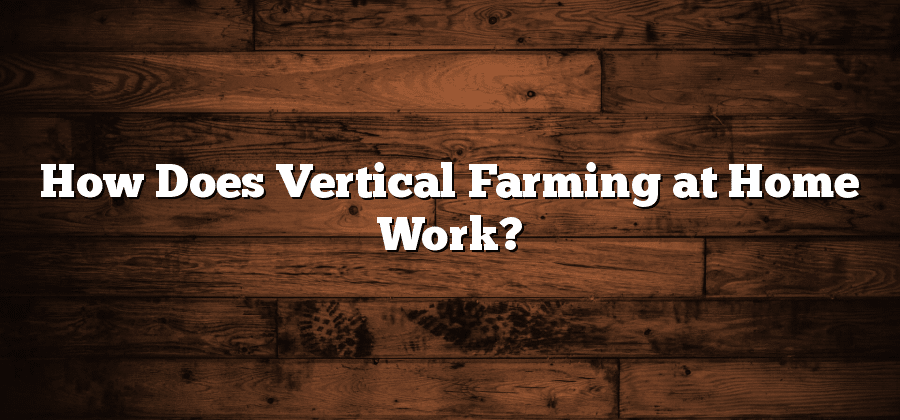Benefits of Vertical Farming at Home
With the rapid urbanization and limited availability of agricultural land, vertical farming has emerged as a promising solution for growing food right at home. One of the main benefits of vertical farming is its space-saving advantage. By utilizing vertical space, homeowners can maximize their limited land area and grow a variety of crops throughout the year.
Another benefit is the reduction in transportation costs. With vertical farming, produce doesn’t need to travel long distances from farm to market, significantly cutting down on fuel consumption and carbon emissions. This not only makes vertical farming more environmentally friendly but also ensures fresher and more nutritious harvests. Additionally, vertical farming eliminates the need for harmful pesticides and herbicides, promoting healthier and safer food options for individuals and families.
Equipment Needed for Vertical Farming
Equipment plays a crucial role in the success of vertical farming at home. Before setting up your own vertical farm, it is essential to have the right tools and machinery in place. One of the most important pieces of equipment is a vertical farming system, which typically includes racks or shelves to hold the plants, growing lights, and a system for nutrient delivery such as hydroponics or aeroponics. Additionally, a good irrigation system is necessary to ensure the plants receive the right amount of water. Other equipment that may be required includes fans or ventilation systems to control temperature and airflow, grow lights to provide artificial sunlight, and sensors or monitoring systems to keep track of various environmental factors such as temperature, humidity, and pH levels.
Investing in high-quality equipment is crucial to ensure efficient and successful vertical farming. While the initial costs may be higher, durable and reliable equipment will help maximize production and minimize risks. Additionally, it is important to regularly maintain and service the equipment to ensure it remains in optimal condition. By investing in the right tools and machinery, aspiring vertical farmers can create a productive and sustainable indoor farming system that can provide fresh produce year-round.
Choosing the Right Location for Your Vertical Farm
When considering a location for your vertical farm, there are several factors to take into account. Firstly, it is crucial to assess the availability of space. Vertical farming requires a significant amount of vertical height, so ensure that the location you choose can accommodate the necessary infrastructure. Additionally, consider the accessibility of the site. It is essential to have easy access to your vertical farm for maintenance and monitoring purposes. Look for a location with good transportation links and proximity to your home or workplace for convenience.
Furthermore, the suitability of the environment should not be overlooked. The location should have a stable and consistent climate to ensure optimal plant growth. Avoid areas with extreme temperature fluctuations or excessive humidity, as these can negatively impact the health of your crops. Additionally, assess the availability of natural resources in the vicinity, such as water and electricity, which are essential for the operation of the vertical farm. By carefully considering these factors, you can choose the right location for your vertical farm and set it up for success in the long run.
Selecting the Right Crops for Vertical Farming
When it comes to vertical farming, selecting the right crops is crucial for ensuring a successful and productive harvest. The choice of crops depends on various factors such as space availability, light requirements, and personal preference. One of the key advantages of vertical farming is the ability to grow a wide range of crops, including leafy greens, herbs, fruits, and vegetables. However, it is important to consider the specific needs and characteristics of each crop to maximize yields and maintain consistent quality.
Leafy greens, such as lettuce, spinach, and kale, are popular choices for vertical farming due to their high nutrient content and rapid growth. These crops require relatively short growing cycles and do not require as much vertical space as taller plants. Additionally, herbs like basil, cilantro, and mint can thrive in vertical farming systems, adding flavor and freshness to your home-grown meals. For those who want to venture into fruit production, strawberries and tomatoes can be successfully grown vertically, as they have compact growth habits and can be trained to grow upwards. Understanding the specific requirements of each crop will help you make informed decisions and maximize the potential of your vertical farming setup.
Understanding the Role of Lighting in Vertical Farming
When it comes to vertical farming, one of the key factors to consider is the role of lighting. Lighting plays a critical role in the growth and development of plants, especially in indoor environments where natural sunlight may be limited. In a vertical farm, artificial lighting is used to provide plants with the necessary light energy for photosynthesis.
The type of lighting used in vertical farming is crucial to ensure optimal plant growth and productivity. LED lights have emerged as the preferred choice for vertical farms due to their energy efficiency and customization options. LED lights allow growers to control the spectrum and intensity of light, providing plants with the specific wavelengths needed for different stages of growth. This not only ensures efficient energy usage but also maximizes plant growth and overall yield. Additionally, LED lights produce less heat compared to traditional lighting options, reducing the risk of overheating and damage to the plants. Overall, understanding the role of lighting in vertical farming is essential for creating the ideal growing conditions and ensuring the success of your indoor farm.






